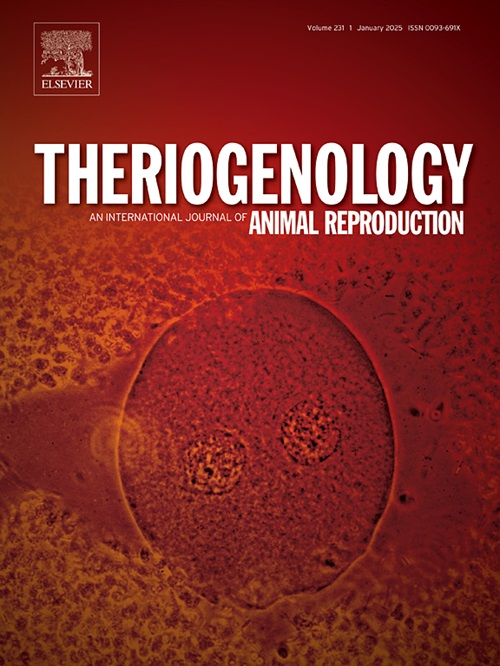Blastocyst production by conventional in vitro fertilization (cIVF) in horses: Effects of sperm storage method, incubation timing of cool-stored semen before gamete co-incubation, and comparisons between cIVF and intracytoplasmic sperm injection (ICSI)
IF 2.5
2区 农林科学
Q3 REPRODUCTIVE BIOLOGY
引用次数: 0
Abstract
Currently, Intracytoplasmic Sperm Injection (ICSI) on in vitro-matured equine oocytes obtained by transvaginal oocyte aspiration (TVA) is the method of choice for in vitro production of equine blastocysts in a clinical setting. A protocol for conventional in vitro fertilization (cIVF) using either fresh or frozen/thawed stallion sperm incubated under capacitating conditions (Tyrode's Albumin Lactate Pyruvate medium + penicillamine, hypotaurine, epinephrine; FERT-PHE) has been recently reported. Several factors that may impact the clinical applicability of this cIVF protocol have yet to be studied. In Experiment 1, a comparison between fresh, cool-stored, or frozen/thawed sperm from a fertile stallion (OP) for cIVF was performed. Differences on cleavage rate (embryos with ≥8 blastomeres at day 5 of culture), blastocyst rate (blastocysts/cleaved embryos), and the number of blastocysts per mare TVA/cIVF cycle were not detected among fresh (68 % [38/56]; 18 % [7/38]; 1), cool-stored (61 % [34/56]; 21 % [7/34]; 1), and frozen/thawed sperm (54 % [29/54]; 21 % [6/29]; 1), respectively (P > 0.05). In Experiment 2, the effect of incubation time (22 vs. 10 h) that cool-stored sperm were exposed to the FERT-PHE medium before gamete co-incubation was studied. Differences on cleavage rate (45 % [29/64] vs. 56 % [47/84]), blastocyst rate/cleaved embryos (28 % [8/29] vs. 19 % [9/47]), and number of blastocysts per mare TVA/cIVF cycle (1.1 vs. 1.3) were not detected between treatment groups (P > 0.05). In Experiment 3, frozen/thawed sperm from 2 fertile stallions (OP vs. HW) was processed to compare cIVF and ICSI cycles. Differences on cleavage rates were not detected between stallions in cIVF (OP: 41 % [16/39] vs. HW: 52 % [34/65]; P > 0.05) or ICSI cycles (OP: 34 % [22/64] vs. HW: 53 % [19/36]; P > 0.05); nor detected when the stallion values were combined: cIVF (48 % [50/104]) vs. ICSI (41 % [41/100]; P > 0.05). Differences on blastocyst rate/cleaved embryos were not detected between stallions in cIVF (OP: 13 % [2/16] vs. HW: 26 % [9/34]) or ICSI cycles (OP: 45 % [10/22] vs. HW 42 % [8/19]; P > 0.05); but when stallion values were combined, blastocyst rate/cleaved embryos was lower for cIVF (22 % [11/50]) than for ICSI (44 % [18/41]) cycles (P < 0.05). The number of blastocysts per mare TVA cycle was lower for stallion OP in cIVF (0.4) than for stallion HW in ICSI (2; P < 0.05), while similar for stallions OP and HW in cIVF cycles (1.5), and stallion OP in ICSI cycles (1.4; P > 0.05). Six blastocysts from cIVF (n = 3) or ICSI (n = 3) cycles produced with frozen/thawed sperm from stallion HW were vitrified, warmed, and transferred into recipient mares. All mares were confirmed pregnant at days 14, 28, and 45 of gestation. In conclusion, in this study, the production of cIVF-derived blastocysts was similar for fresh, cool-stored, or frozen/thawed sperm from a fertile stallion. Reducing the sperm incubation timing in FERT-PHE from 22 to 10 h did not affect blastocyst production by cIVF using cool-stored sperm. Finally, in this study, an overall lower blastocyst rate per cleaved embryo was observed in two fertile stallions when utilizing frozen/thawed sperm for cIVF compared to ICSI. Further studies are warranted to understand additional factors that may affect the production of equine blastocysts by cIVF in a clinical setting.
马常规体外受精(cIVF)的囊胚生成:精子储存方式的影响、配子共孵育前冷藏精液的孵育时间以及cIVF与胞浆内单精子注射(ICSI)的比较
目前,对经阴道卵母细胞抽吸(TVA)获得的体外成熟马卵母细胞进行胞浆内单精子注射(ICSI)是临床上体外培养马囊胚的首选方法。常规体外受精(cIVF)方案使用新鲜或冷冻/解冻的种马精子在使能条件下孵育(Tyrode's白蛋白乳酸丙酮酸培养基+青霉胺、次牛磺酸、肾上腺素;最近报道了FERT-PHE)。可能影响该cIVF方案临床适用性的几个因素还有待研究。在实验1中,对可育种马(OP)的新鲜、冷藏或冷冻/解冻精子进行了cIVF比较。新鲜组的卵裂率(培养第5天卵裂球≥8个)、囊胚率(囊胚数/卵裂胚数)和每个TVA/cIVF周期的囊胚数均无差异(68% [38/56];18% [7/38];1)冷藏(61% [34/56];21% [7/34];1),冷冻/解冻精子(54% [29/54];21% [6/29];1),分别(P >;0.05)。实验2在配子共育前,研究冷藏精子暴露于FERT-PHE培养基的孵育时间(22 h vs. 10 h)对配子共育的影响。两组间在卵裂率(45% [29/64]vs. 56%[47/84])、囊胚率/卵裂胚数(28% [8/29]vs. 19%[9/47])和每个TVA/cIVF周期囊胚数(1.1 vs. 1.3)方面均无差异(P >;0.05)。在实验3中,对2匹可育种马(OP vs. HW)的冷冻/解冻精子进行处理,比较cIVF和ICSI周期。在cIVF中,公马之间的卵裂率没有差异(OP: 41% [16/39] vs. HW: 52% [34/65];P比;0.05)或ICSI周期(OP: 34% [22/64] vs. HW: 53% [19/36];P比;0.05);当将种马值合并时也未检测到:cIVF (48% [50/104]) vs. ICSI (41% [41/100]);P比;0.05)。在cIVF (OP: 13% [2/16] vs. HW: 26%[9/34])或ICSI周期(OP: 45% [10/22] vs. HW: 42%[8/19])中未检测到不同种马之间囊胚率/卵裂胚胎的差异;P比;0.05);但当结合种数时,cIVF周期的囊胚率/裂胚率(22%[11/50])低于ICSI周期(44% [18/41])(P <;0.05)。cIVF组的种马OP(0.4)比ICSI组的种马HW(2)更低;P & lt;而cIVF周期的种马OP和HW相似(1.5),ICSI周期的种马OP相似(1.4;P比;0.05)。用公马HW的冷冻/解冻精子产生的cIVF (n = 3)或ICSI (n = 3)周期的6个囊胚被玻璃化、加热并转移到受体母马。所有母马均在妊娠第14、28和45天确认怀孕。总之,在本研究中,civf衍生囊胚的产生与来自可育种马的新鲜、冷藏或冷冻/解冻精子相似。将FERT-PHE中的精子孵育时间从22小时减少到10小时,不影响使用冷藏精子进行cIVF的囊胚产生。最后,在本研究中,与ICSI相比,在使用冷冻/解冻精子进行cIVF的两匹可育种马中,观察到每切割胚胎的囊胚率总体较低。进一步的研究是必要的,以了解其他因素,可能会影响马胚泡生产的cIVF在临床设置。
本文章由计算机程序翻译,如有差异,请以英文原文为准。
求助全文
约1分钟内获得全文
求助全文
来源期刊

Theriogenology
农林科学-生殖生物学
CiteScore
5.50
自引率
14.30%
发文量
387
审稿时长
72 days
期刊介绍:
Theriogenology provides an international forum for researchers, clinicians, and industry professionals in animal reproductive biology. This acclaimed journal publishes articles on a wide range of topics in reproductive and developmental biology, of domestic mammal, avian, and aquatic species as well as wild species which are the object of veterinary care in research or conservation programs.
 求助内容:
求助内容: 应助结果提醒方式:
应助结果提醒方式:


